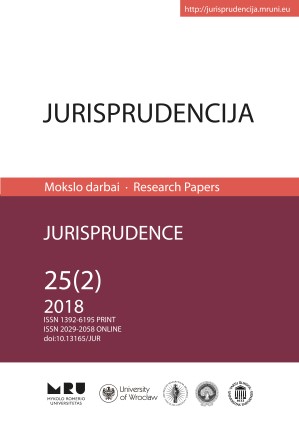KOVOS SU TIESIOGINIŲ MOKESČIŲ VENGIMU
TAISYKLIŲ HARMONIZAVIMAS ES IR JO ĮTAKA
NACIONALINĖMS KOVOS SU MOKESTINIU PIKTNAUDŽIAVIMU TAISYKLĖMS
EU HARMONIZATION OF THE ANTI-AVOIDANCE RULES IN DIRECT TAXATION AND THE IMPACT OF IT ON THE NATIONAL RULES AGAINST TAX ABUSE
Author(s): Ingrida SteponavičienėSubject(s): Law, Constitution, Jurisprudence, EU-Accession / EU-DEvelopment, Fiscal Politics / Budgeting, EU-Legislation
Published by: Mykolas Romeris University
Keywords: Direct taxation; tax abuse; general anti-avoidance rule; GAAR; harmonisation; ATAD, implementation of directive; principle of legal certainty;
Summary/Abstract: The article examines the impact of the recent major changes in EU direct taxation on the national anti-avoidance rules of Lithuania. It mainly focuses on the increasing EU harmonisation in the field of anti-tax avoidance, first-of-all on the Council Directive (EU) 2016/1164 of 12 July 2016, introducing the general antiavoidance rule to be transposed by all EU member-states, including Lithuania. As far as Lithuania already has a national general anti-avoidance rule set by the Law on Tax Administration, it is considered whether the Lithuanian national general antiavoidance rule is stricter or softer than the EU-wide general anti-abuse rule indicated in Article 6 of the Council Directive (EU) 2016/1164 and consequently, whether the national general anti-avoidance rule should or could be amended in transposing the beforementioned EU directive, and if so, in what manner it should be done.For comparing and evaluating the national and EU general anti-avoidance rules such criteria as scope of application, identification of special schemes and manner of defining tax purpose are taken into consideration. For the throughout examining of Part 1 of Article 69 of the Law on Tax Administration against Article 6 of the Council Directive (EU) 2016/1164 linguistic, systematic, comparative, logic, historical, teleologic and other research methods are used. As a result, it is concluded that main uncertainties in national regulation and the difference between national and EU general anti-avoidance rule lies in formulation of tax purpose. In opposite to the EU rule, the national rule is formulated in a way it could be applied in any situation where tax purpose may be identified. Moreover, the wording of national rule indicates the objective element (aiming for tax benefit) but is silent about subjective element (tax benefit must be sought in contradiction to the aim of tax law, i.e. in abusing tax law) of the tax purpose, even though both elements are essential for applying general anti-avoidance rule. Although such questionable formulation of law is in practice mitigated by the court (both national and ECJ) practice, it nevertheless brings legal uncertainty. Furthermore, the EU general anti-abuse rule introduces stricter standard of the importance of tax purpose (tax abuse may be recognised not only in cases where tax benefit is not merely sole purpose but also when it is one of the main purposes). Therefore, it is proposed that the national legal regulation of general tax-avoidance rule should be amended both for transposing properly the EU anti-tax avoidance directive (EU) 2016/1164 and for taking a step towards ensuring better legal certainty in national tax law.
Journal: Jurisprudencija
- Issue Year: 25/2018
- Issue No: 2
- Page Range: 498-526
- Page Count: 29
- Language: Lithuanian

